- NEED HELP? CALL US NOW
- +919995411505
- [email protected]
CEMENTUM
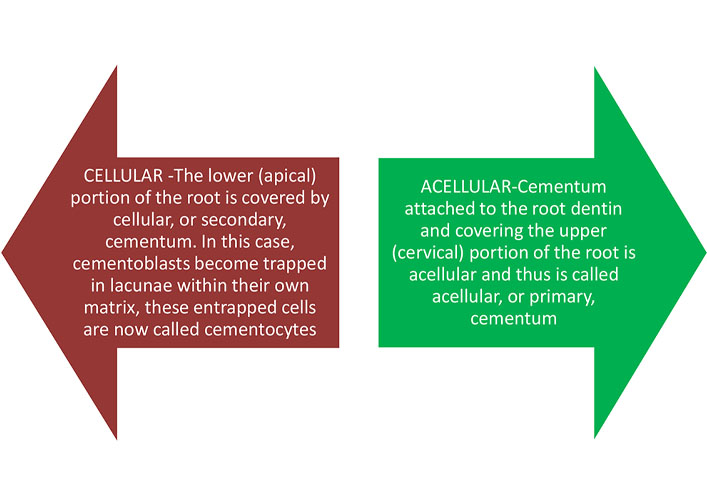
INTRODUCTION
- It is a mineralized dental tissue covering the anatomic roots of human teeth (Orbans).
- It was first demonstrated microscopically in 1853 by Frankel and Raschkow
- Begins at the cervical portion of the tooth and extends upto the apex
- Medium for attachment of collagen fibers that bind the tooth to surrounding structures
- Cementum covers the roots of the teeth and is interlocked firmly with the dentin of the root
- Cementum is a mineralized connective tissue similar to bone except that it is avascular; the mineral is also apatite, and the organic matrix is largely collagen.
- The cells that form cementum are called cementoblasts.
- The two main types of cementum are cellular and acellular.
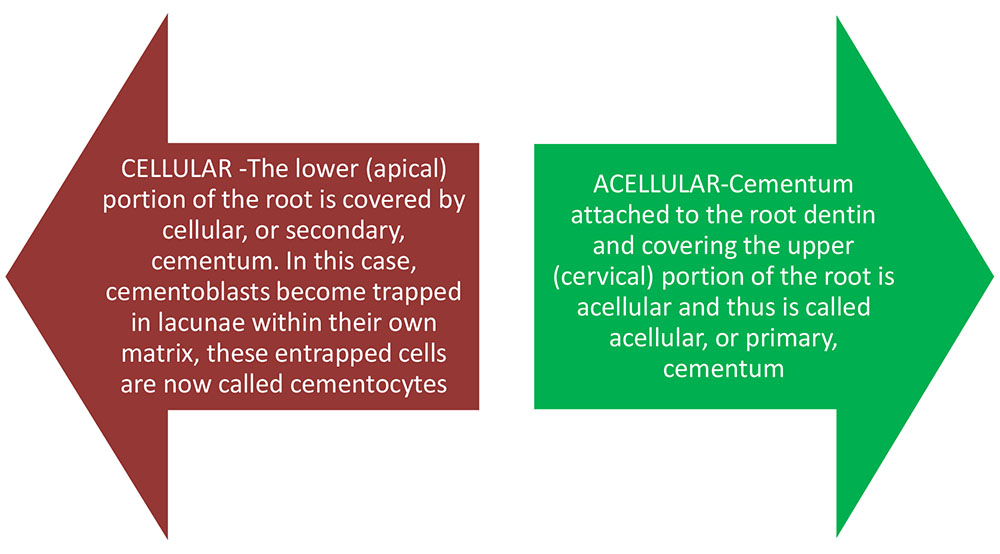
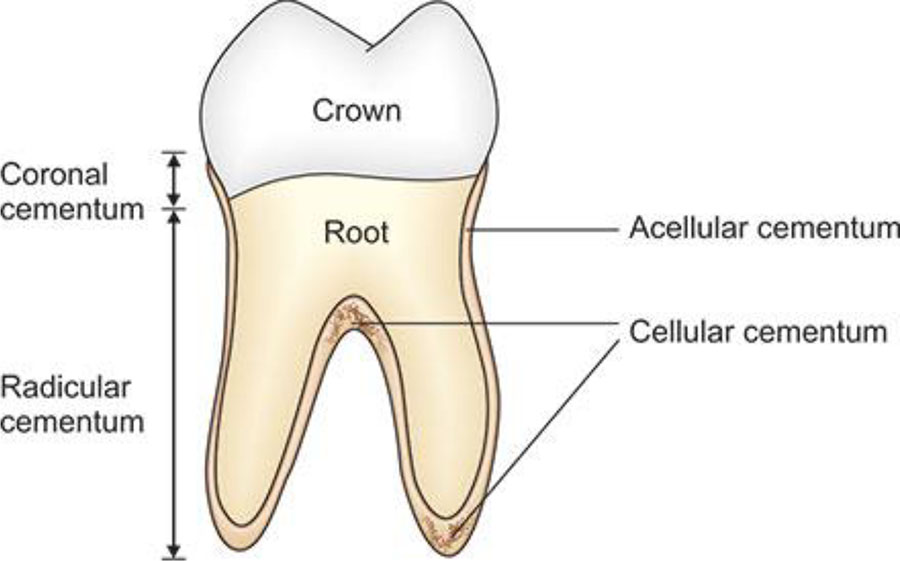
DEVELOPMENT OF THE CEMENTUM
- The cementum is derived from the investing layer of the dental follicle.
- Over the surface of the cementum, there lies a thin layer about 3-5 µm in thickness that is not calcified called the precementum
STRUCTURE OF CEMENTUM
- The thickness of the cementum varies at different levels of the tooth root.
- It is thickest at the apex of the root and between two roots when a tooth has more than one root.
- It is thinnest at the upper part of the root.
- The cells of cementum are the entrapped cementoblasts, the cementocytes.
- Cementocytes are cementoblasts enclosed in a self-generated matrix.
- Cementoblast is a cell that originates from follicular cells around the root of the tooth, and its function is cementogenesis. Cementocytes reside in a mineralized extracellular matrix of the cellular cementum.
- Each cementocyte lies in its lacuna, similar to the pattern noted in bone.
- These lacunae also have canaliculi or canals.
- These canals in cementum do not contain nerves, nor do they radiate outward.
- Instead, the canals are oriented toward the periodontal ligament and contain cementocytic processes that exist to diffuse nutrients from the ligament because it is vascularized.
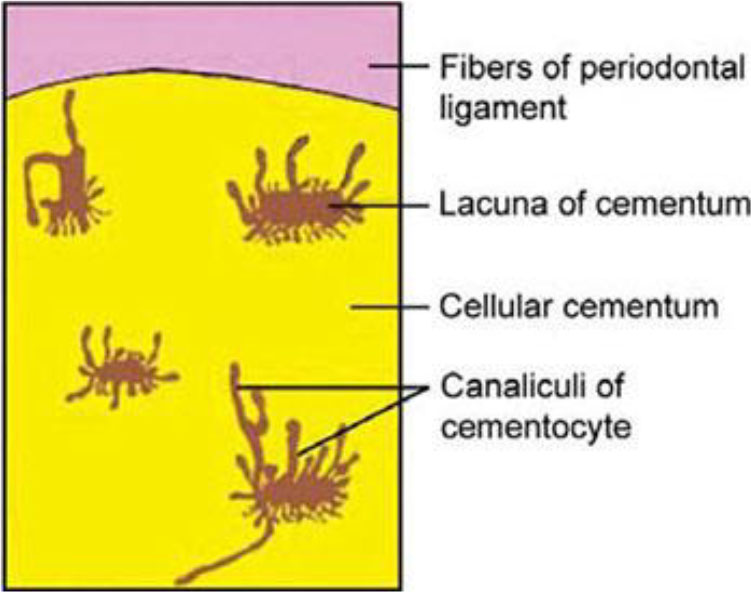
PROPERTIES
| PHYSICAL PROPERTIES | CHEMICAL PROPERTIES |
|
|
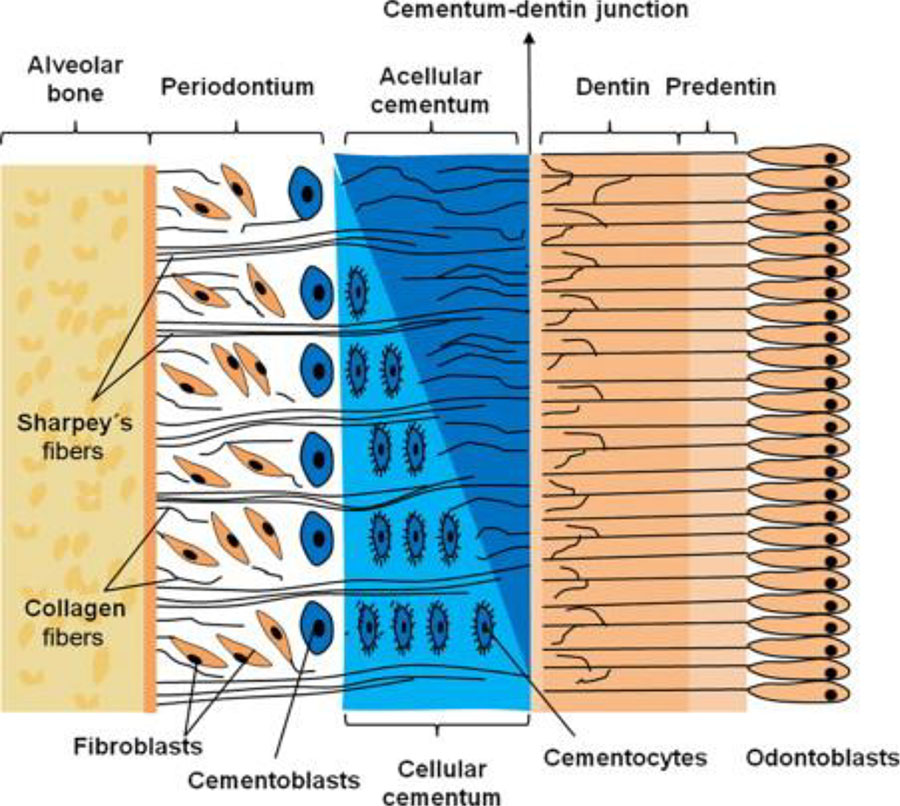
CEMENTOGENESIS
Cementum formation takes place rhythmically.
- The rate of formation of cellular cementum is much more rapid than that of acellular cementum.
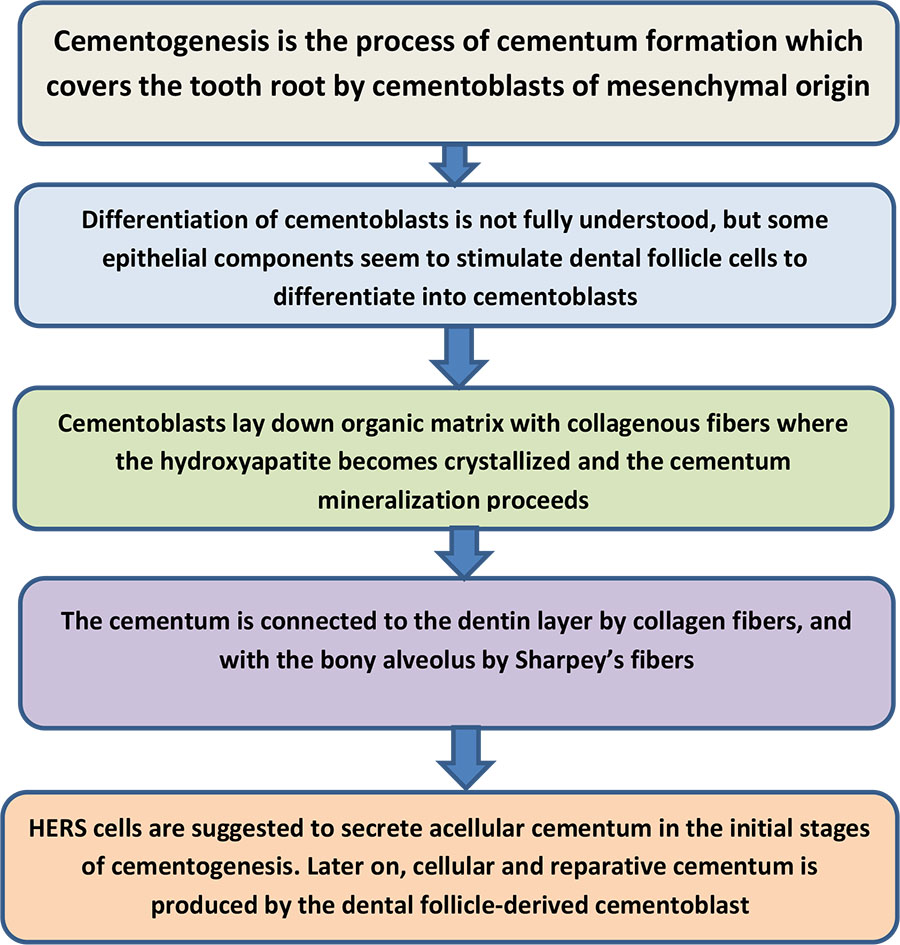
TYPES

- Cementum contains two types of fibers, i.e. extrinsic (Sharpey's) fibers which are embedded ends of the principal fibers and intrinsic fibers which are fibers of cementum proper.
- It is believed that the extrinsic fibers are secreted by fibroblasts and partly cementoblasts and that the intrinsic fibers are secreted by only cementoblasts.
- Jones added these fibers to items of cementum classification, and Schroeder established the current classification, which is now widely used in the dental field.
- In accordance with this classification, three major types of cementum are
- “Acellular extrinsic fiber cementum (AEFC)” contains densely packed extrinsic fibers and no cementocytes AEFC corresponds to classical acellular cementum.
- “Cellular intrinsic fiber cementum (CIFC)” contains intrinsic fibers and cementocytes.
- “Cellular mixed stratified cementum (CMSC)” corresponds to classical cellular cementum.
FUNCTIONS OF CEMENTUM
- Cementum furnishes a medium for the incorporation of the principal periodontal fibers, thereby securing the binding of the tooth root to the alveolar bone .
- Cementum serves as a reparative tissue in case of root fracture or resorption .
- Functional adaptation : When the superficial layer of cementum functionally ages, a subsequent layer is deposited thus restoring the integrity of the attachment apparatus .
REPAIR
Anatomic repair
- Generally occurs when the degree of destruction is low
- The root outline is re- established as it was before cemental resorption
Functional repair
- Occurs in cases of large cemental resorption or destruction
- To maintain the width of periodontal ligament, the adjacent alveolar bone grows and takes the shape of defect following the root surface.
- This is done to improve the function of tooth
ANAMOLIES IN CEMENTUM
- Hypercementosis: It is an abnormal thickening of cementum, may be diffuse or circumscribed. It may affect all teeth of the dentition, be confined to a single tooth, or even affect only parts of one tooth. If the overgrowth occurs in functional teeth and improves the functional qualities of the cementum, it is termed cementum hypertrophy. If the overgrowth occurs in nonfunctional teeth, it is termed cementum hyperplasia .
- Enamel pearls - Enamel pearls are localized masses of enamel that develop ectopically, typically over the root surface, in close proximity to cemento-enamel junction.
- Concresence This is a form of fusion which occurs after the root formation has been completed.Here the teeth are united by cementum only
- Enamel projections - If the amelogenesis is not turned off after the enamel of the crown has been laid down. The enamel organ may continue to produce enamel over the root dentin.
- Ankylosis- Fusion of cementum and alveolar bone with obliteration of periodontal ligament
- Cementicles : they are ovoid or round calcified structure that exhibits by dystrophic calcification of the degenerated periodontal tissue or the epithelial rests of Malssez . They nidus favoring the deposition of concentric layers of calcosherites around the degenerated or hemorrhagetic areas .
Cementicles may be:
- Free in the periodontal ligament.
- Attached the cementum and form excementosis.
- Embedded in the cementum during its growth by age.
AGE CHANGES OF CEMENTUM
- Smooth surface becomes irregular.
- Decrease permeability: by aging the permeability of cementum decreses gradually, the permiability from the periodontal ligament side is lost except in the most recent formed layers of cementum
- Continues deposition of cementum occurs with age in the apical area.
- Cementum resorption active for a period of time and then stops for cementum deposition creating – reversal lines.
- Resorption of root dentin occurs with aging which in covered by Cemental repair.
CEMENTOENAMEL JUNCTION
The cementoenamel junction (CEJ) can have different morphologies, known as Choquet cases or types
TYPE 1 The cementum overlaps the enamel
TYPE 2 The enamel overlaps the cementum
TYPE 3 The cementum and enamel is edge-toedge
TYPE 4 There is a gap between the enamel and the cementum
- In 60% of the teeth cementum Overlaps enamel
- In 30% of the teeth cementum just Meets enamel OR edge to edge
- In 10% of the teeth there is a small Gap between cementum and enamel
Related posts
April 10, 2025
April 9, 2025
April 4, 2025




